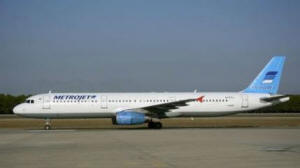|
 Russian
airliner with 224 aboard crashes in Egypt's Sinai Russian
airliner with 224 aboard crashes in Egypt's Sinai
 Send a link to a friend
Send a link to a friend
[October 31, 2015]
By Yusri Mohammed and Ahmed Mohamed Hassan
ISMAILIA, Egypt/CAIRO (Reuters) - A
Russian airliner carrying 224 passengers and crew crashed in Egypt's
Sinai peninsula on Saturday, the Egyptian civil aviation authority said,
and a security officer who arrived at the scene said most of the
passengers appeared to have been killed.
|
|
 The Airbus A 321, operated by Russian airline Kogalymavia,was
flying from the Sinai Red Sea resort of Sharm el-Sheikh to St
Petersburg in Russia when it went down in a desolate mountainous
area of central Sinai soon after daybreak, the aviation ministry
said. The Airbus A 321, operated by Russian airline Kogalymavia,was
flying from the Sinai Red Sea resort of Sharm el-Sheikh to St
Petersburg in Russia when it went down in a desolate mountainous
area of central Sinai soon after daybreak, the aviation ministry
said.
The security officer at the scene told Reuters by telephone that
search and rescue teams heard voices in a section of the plane.
"I now see a tragic scene. A lot of dead on the ground and many who
died whilst strapped to their seats," the officer, who requested
anonymity, said.
"The plane split into two, a small part on the tail end that burned
and a larger part that crashed into a rock. We have extracted at
least 100 bodies and the rest are still inside."
Sinai is the scene of an insurgency by militants who support Islamic
State. The rebels have killed hundreds of Egyptian soldiers and
police and have also attacked Western targets in recent months.

Russia launched air raids against Syrian opposition groups including
Islamic State on Sept. 30. Civil Aviation Minister Mohamed Hossam
Kemal was quoted in a cabinet statement as saying it was too soon to
determine the cause of the crash, but security sources said there
was no indication the Airbus had been shot down or blown up.
PREMIER HEADS TO SCENE
Egyptian Prime Minister Sherif Ismail was heading to the crash site
with several cabinet ministers on a private jet, the tourism
ministry said.
Russian television showed film of anxious relatives and friends
waiting for information at St. Petersburg's Pulkovo airport.
The A321 is a 185-seat medium-haul jet in service since 1994, with
over 1,100 in operation worldwide and a good safety record. It is a
highly automated aircraft relying on computers to help pilots stay
within safe flying limits.
Saturday's crash is the second fatal accident involving this variant
of the A320 jetliner family, according to data from the Flight
Safety Foundation.
[to top of second column]
|

Airbus said it had no independent information on the crash and
declined to comment on the aircraft involved.
The aircraft took off at 5:51 a.m. Cairo time (0351 GMT) and
disappeared from radar screens 23 minutes later, Egypt's Civil
Aviation Ministry said in a statement. It was at an altitude of
31,000 feet (9,400 meters) when it vanished from radar screens.
Accidents at cruising altitude are one of the rarest categories of
accidents but also among the most deadly, accounting for 13 percent
of fatal accidents but 27 percent of fatalities since 2005,
according to Boeing.
According to FlightRadar24, an authoritative Sweden-based flight
tracking service, the aircraft was descending rapidly at about 6,000
(2,000 meters) feet per minute before the signal was lost.
The aircraft cited in tracking reports had two engines from the
International Aero Engines consortium, which includes United
Technologies <UTX.N> unit Pratt & Whitney and Germany's MTU Aero
Engines <MTXGn.DE>
After delays caused by poor weather conditions, Egyptian search and
rescue teams located the site of the crash in the Hassana area 35 km
(22 miles) south of the Sinai Mediterranean coastal city of Al
Arish, the aviation ministry statement said.

(Additional reporting by Ehab Farouk; editing by Ralph Boulton;
Writing by Michael Georgy; editing by Ralph Boulton)
[© 2015 Thomson Reuters. All rights
reserved.]
Copyright 2015 Reuters. All rights reserved. This material may not be published,
broadcast, rewritten or redistributed. |